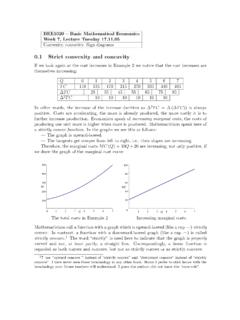Transcription of When is a Time Series I(0)? - Exeter
1 when is a time Series I(0)? James Davidsony University of Exeter Forthcoming in The Methodology and Practice of Econometrics, a festschrift for David F. Hendry, Eds. Jennifer Castle and Neil Shepherd, Oxford University Press. Abstract This paper surveys the extensive recent literature on the problems of deciding what is meant by an I(0) process, and then deciding how to test for the property. A formidable di culty exists in the construction of consistent and asymptotically correctly sized tests for the I(0) hypothesis, and this may appear to place a question mark over the validity of a large area of econometric theory and practice. To overcome these di culties in practical applications, the paper proposes that a slightly di erent question needs to be posed, relating to the adequacy of approximation to asymptotic inference criteria in nite samples.
2 A simulation- based test, aimed at discriminating between data sets on this basis, is examined in a Monte Carlo experiment. 1 Introduction Since the inception of integrated time Series modelling in econometrics, the question of what constitutes a non-integrated'process has remained troublingly elusive. The inferential techniques developed for cointegration and related analyses require for their validity that the di erences of the data Series possess certain critical properties. These properties are nearly the same as those required for classical'asymptotics or, in other words, the application of the central limit theorem to approximate the distribution of regression coe cients and similar quantities.
3 The project of doing time Series econometrics could hardly be viable, one would suppose, unless these properties could be both clearly delineated, and subject to veri cation. Before the advent of cointegration these problems were often resolved willy-nilly, by an as- sumption of correct speci cation in the context of a fairly heroic conditioning exercise, whereby the explanatory variables in a model were held to be xed in repeated samples'. The only sto- chastic components left to model (the disturbances) could then be treated as independently and identically distributed, and their treatment was elementary. However implausible these classical assumptions may always have been, they are manifestly inadequate to deal with cointegration models, because here it not possible to hold the data conditionally xed.
4 It is the observed Series themselves, not constructed disturbances, whose distributions must satisfy the critical regularity conditions. This paper shares a title with the rst version of a working paper that subsequently appeared as Davidson (2002). It further explores some themes that the earlier working paper broached rather brie y. I am glad of this excuse to revive a nice title, although there is in practice minimal overlap between the content of this paper and its predecessor. y Address for correspondence: 1. 2 De ning I(0). Early contributions to the cointegration literature tended to be fairly casual in their treatment of I(0), perhaps because this component of the theory was viewed as inherited from the pre-existing modelling methodology.
5 The following de nitions are culled from some widely cited articles and monographs. 1. De nition: A Series with no deterministic component which has a stationary, invertible ARMA representation after di erencing d times is said to be integrated of order (Engle and Granger 1987, p. 252.). 2. It follows that [..] a short-memory Series is I(0), as it needs di erencing zero times (Engle and Granger 1991, p. 3). 3.. if the Series must be di erenced exactly k times to achieve stationarity then the Series is I(k), so that a stationary Series is I(0). (Banerjee, Dolado, Galbraith and Hendry 1993, p. 7.). 4. A nite (non-zero) variance stochastic process which does not accumulate past errors is said to be integrated of order (Hendry 1995, p.)
6 43). P1 P1 i 5. A stochastic process Yt which P1 satis es Yt E(Y t ) = i=0 Ci " t i is called I(0) if [ i=0 Ci z converges for jzj < 1 and] i=0 Ci 6= 0. (Johansen 1995, p. 34-35, the condition "t s iid(0; 2 ) being understood.). Of these (chronologically ordered) quotations, 2, 3 and 4 can be thought of as informal and descriptive, while 1 and 5 are intended as more rigorous. Even so, it's interesting to note that they are by no means equivalent. The concepts of stationarity, short memory and nite variance are each singled out as de ning'descriptive characteristics, but it is not yet clear how these might be connected with one another. On the other hand, the more formal de nitions restrict attention to a limited class of linear models, in which the three characteristics of stationarity, short memory and (under Gaussianity) nite variance are united in a single parametric restriction.
7 Note that in a more general framework it easy to dispense with one while retaining another. The inclusion of deterministic components ( trend stationarity') is only one of the many ways these models might be generalized. Another approach to de nition is the pragmatic one of simply specifying conditions under which the asymptotic theory is valid; see for example Stock (1994), Davidson (2002) and M ller (2008). These conditions are of course what motivate the technical and informal de nitions just given, but in many ways it simpli es the analysis to state the desired properties directly, rather than conditions su cient for them. Thus, De nition 1 A time Series fxt g1. t=1 is I(0) if the partial sum process XT de ned on the unit interval by [T ].
8 X. 1. XT ( ) = ! T (xt Ext ); 0 < 1 ( ). t=1. P. where ! 2T = Var( Tt=1 xt ), converges weakly to standard Brownian motion B as T ! 1: This de nition rst makes it clear that I(0) is an attribute of an in nite stochastic sequence. In other words, it is not a well-de ned concept for observed time Series except in the context of limit arguments as T ! 1. Next, note that it implies the property ! 2T s T ! 2 for 0 < ! 2 < 1, because otherwise the limit process cannot have the Brownian property E(B(s) B(r))2 ) = s r 2. for 0 r < s 1. For full applicability, it might need to be supplemented by the condition that a consistent estimator of ! 2 exists, which typically will be one of the class of kernel estimators.
9 See Newey and West (1987) and Andrews (1991) inter alia. However, the best known su cient conditions for these twin convergences, in distribution and probability, are in fact quite similar;. see de Jong and Davidson (2000). It is quite possible that the best conditions actually coincide. Moreover, Kiefer, Vogelsang and Bunzel (2000) have shown that valid inference is possible without consistent variance estimation, although as pointed out below, their results don't have application for testing the I(0) hypothesis, in particular. What is clear is that a very wide class of processes satisfy these conditions, of which the cases cited by Engle-Granger (1987) and Johansen (1995), respectively, form only a small subset.
10 3 Conditions for I(0). Davidson (2002 and 2006, Section ) provides a convenient summary of the technical conditions that ensure the property given in De nition 1 holds. A set of conditions is given for linear models that are e ectively necessary for I(0), in the sense that convergence to a non-Brownian limit process (fractional Brownian motion) can be demonstrated in cases where they are violated. Summability of the autocovariances (though not necessarily absolute summability) is the fun- damental necessary condition for I(0), because on this condition depends the property E(! 2T ) s T ! 2 . Consider the class of covariance stationary moving average processes de ned by 1. X 1. X.










